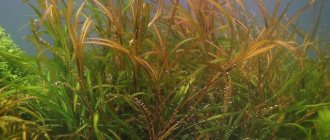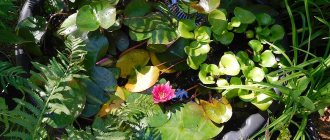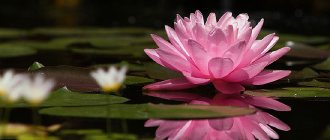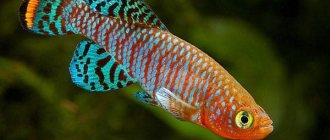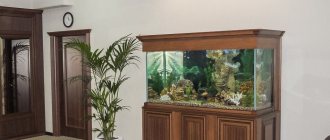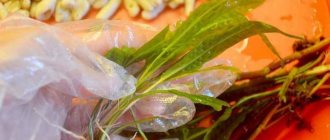Views: 2,791
Delicate, extraordinary beautiful nymphea flowers have already captivated our summer residents. Many people call them water lilies or water lilies. Increasingly, these ornamental plants decorate reservoirs and ponds in many household plots. A decorative pond with charming nymphs surrounded by leaves that lie on the surface of the water is a beautiful and unforgettable element of landscape design. Decorate a decorative pond with nymphs and how to properly care for a beautiful plant?
- Pests of nymphs How to plant nymphs correctly
Description of the nymph
Nymphs (Nymphaea) are rightfully considered the queens of water. Nymphea is a unique, beautifully blooming flower, about which legends and unusual stories are written. Nymphea got its name in honor of the gentle semi-divine nymphs - patroness of nature and the water element.
Among the Slavic peoples, the water lily is associated with fairy-tale mermaids.
According to Scandinavian legends, each water lily has its own elf friend, who is born and dies with the flower. Nymphaeans are often mentioned in ancient Greek myths. Nymphea is sometimes called the “child of the sun”: its magnificent flowers open in all their glory with the first rays of the sun, and close at dusk.
Nymphea is a perennial herbaceous aquatic plant with a powerful, fleshy rhizome, the genus of which consists of 50 species. In nature there are tropical and winter-hardy plant species adapted to our climatic conditions. Nymphs grow in flowing reservoirs with slowly flowing water.
Flowering of nymphs in northern latitudes begins in June, in southern regions - in May. Beautiful delicate flowers of white, yellow, pink, lilac shades open in the morning and close, falling into the water when the sun sets. In cloudy, rainy weather, the water lily may not appear on the surface of the water. The duration of flowering of the water lily is up to 4 days, then it dies.
The water lily flower is single, bisexual, and has a regular symmetrical shape. Flowers can be double or semi-double. The diameter of the flower varies from 3 cm to 30 cm. In the center there are numerous large stamens, colored yellow or orange. Nymphs emit a bright aroma that is attractive to numerous insects that pollinate it.
The main pollinators of water lilies are beetles.
If the beetle does not have time to fly away from the bowl of the flower before it closes, it remains inside the water lily and goes under the water with it, and returns to the surface of the water in the morning. The stems are powerful rhizomes, immersed horizontally in the bottom soil or have the shape of tubers. Numerous long roots extend from the tubers, holding the flower in the soil of the reservoir.
Above-water leaves and flower stalks are located on the surface of the water, and they captivate the eye with their splendor. The shape of the surface leaf plates is round, elliptical, with a pronounced notch. The leaves are dense, with a waxy coating, thanks to which they do not get wet.
The size and color of emergent foliage may vary depending on the type of plant. Decorative leaves of water lilies can be deep green or light green, burgundy, and variegated. Elastic leaf petioles, under the influence of wind or the current of a reservoir, move freely along the surface of the water.
The length of the petioles depends on the depth of the pond and the water level in it. Leaves underwater have a different structure: broadly lanceolate, membranous, rolled into a cap , under which are located flower buds and developing above-water leaves. Throughout the vegetative part of an aquatic plant there are air channels that provide it with breathing and allow it to float on water.
Recommendations for beginners
Nymphea is a beautiful aquarium plant that requires patience and skill. And although experienced flower growers understand the intricacies of keeping them, some mistakenly call the nymphea a capsule, the bushes of which can grow in the shade, and flowering is accompanied by small yellow flowers.
(Visited 262 times, 1 visits today)
Nymphea varieties
To decorate a decorative pond, water lilies of different sizes are used, which are selected according to the depth of their planting. Nymphs can be divided into three main groups.
Nymphea dwarf
This is a miniature water lily with a flower with a diameter of 3 to 15 cm. The planting depth of the plant is from 15 cm to 50 cm. You can buy a dwarf nymph for a pond in the store; for convenience, dwarf varieties o.
Among the popular varieties used for decorative ponds:
- Alba - white water lily.
- Rubra - dark red flowers.
- Aurora is a chameleon variety, at the beginning of flowering the flowers are creamy yellow, towards the end of flowering they acquire an orange tint.
Nymphea average
The flower is larger, up to 18 cm. Can be planted in a pond up to 60 cm deep.
Varieties of medium-sized water lilies:
- RoseArey is a beautifully flowering water lily, up to 15 cm in diameter with soft pink petals that fade in the sun and acquire a pale, almost white hue. Thanks to this feature, the pond looks especially attractive.
- Helvola is a yellow-flowered nymph. Attraction is a flower with red petals dotted with medium-sized white spots.
Nymphea large
Water lily flowers are large, reaching a diameter of up to 25 cm, and can be planted in a pond up to 1 meter deep.
Varieties of large-flowered nymphea:
- Chromatella is a yellow water lily that prefers partial shade and is planted in ponds up to 1.5 meters deep.
- Escarboucle is a nymph with bright crimson petals, the flower closes late at night.
The best varieties are presented in the table:
| Petal color | Dwarf | Average | Large |
| White | ALBA | ALBATROS | WHITE SENSATION |
| Red | RUBRA | ATTRACTION | JAMES BRYDON |
| Yellow | AURORA | HTLVOLA | CHROMATELLA |
| Pink | NIGEL | ROSEY AREY | PINK POM POM |
How to plant in a pond
The success of growing nymphs in a pond depends on quality planting. To plant the plant, you will need a low, wide container with drainage holes to allow the rhizome to grow and reproduce more freely. For dwarf varieties, small buckets are suitable, for medium and large varieties - 10-12 liter buckets or other large containers. In addition, in flower shops you can purchase special baskets for planting nymphs.
Next, you need to prepare the ground for planting nymphs; the composition of the soil consists of:
- 1/3 wet clay, free of sand and lumps;
- 1/3 garden soil, with the addition of peat;
- 1/3 cow dung (burnt).
All components must be mixed well and placed at the bottom of the container. For planting, it is recommended to first use humus, and only then the soil mixture. When planting a plant, the rhizome should be positioned horizontally, directing the roots down, gradually covering them with earth and compacting them.
The edge of the rhizome opposite the growing bud must be placed close to the wall of the bucket to allow the root to grow freely. To prevent the soil from being washed out by water, a layer of clean sand is poured on top of the earthen mixture and small stones or pebbles are placed.
Planting and care of nymphs
Containers with planted water lilies can be placed on the bottom of the reservoir at the optimal depth for them, taking into account which group they belong to. The planting depth of the nymph is calculated based on the surface of the soil in the container, and not on the bottom of the pond.
It is worth considering that at depth the water has a rather low temperature, since it is poorly heated by the sun, it will be much more difficult for leaves and flower buds to reach the surface of the reservoir. However, immersing the container with the water lily too shallowly is undesirable - the leaves and flowers of the nymphea grow quite quickly and will be above the water in just a few days.
Nymphs begin to bloom soon after planting.
If you decide to purchase a beautiful nymphea in a store where it is sold in a special container, follow these recommendations: After purchasing, the plant should be planted immediately, without waiting for it to dry out. As a rule, water lilies are sold in containers filled with water or sprinkled with perlite.
When choosing a plant, pay attention to the number of dormant buds.
Take a closer look to make sure there are no signs of rot. You should also carefully examine the rhizome. After purchasing, it is advisable to rinse the root with running water to prevent possible infections or pests from entering the pond.
Video - planting nymphs, water lilies
Content
- 1. Description 1.1. Popular varieties and varieties
The genus Nymphea belongs to the water lily family (Nymphaeaceae). There are about 50 varieties of Nymphaeums. Among them there are cosmopolitans that take root in fresh water bodies from South America to the tundra: Nymphaea tetragona, Nymphaea alba, Nymphaea candida.
Nymphs are able to grow, bloom and bear fruit with a significant decrease in water level and even on land. For this they are called amphibious plants.
Distributed on all continents of the globe. In ancient times they were often mistaken for Lotuses. The famous Egyptian lotus is actually Nymphaea lotus. The Red Indian Lotus (Latin: Nymphaea rubra) and the Nile Blue Lotus (Latin: Nymphaea caerulea) are widely known. In Rus', the dried rhizome of Nymphea was called overcome-grass and was worn as a talisman.
Pond care
Caring for nymphs is not difficult; it is enough to remove dead flowers and yellowed leaves. It is worth noting that water lilies grow very quickly on the surface of the water. When the leaves cover the entire surface of the pond, the flowers become smaller and bloom less often. Therefore, when planting water lilies in a pond, it is necessary to leave at least half of the pond free and not plant too many plants.
A mandatory condition for caring for a pond is its spring cleaning, after wintering the nymphs. The container immersed in water must be removed and cleaned of organic debris and fallen leaves. The pond should also be cleared of debris and dead coastal plants.
How to deal with pests and diseases?
Caring for water lilies requires attention to detail as they can be susceptible to pests, diseases and overcrowding.
Water lilies are attacked by insects such as midge larvae, which damage their leaves if left unchecked. The situation can be prevented by first adding species such as mosquito fish to the aquarium, which will absorb both adult and larval midges.
Another common pest is the water lily leaf beetle, which feeds on the leaves. You can remove them manually or by covering the aquarium with a light-proof cloth.
Water lily propagation
Nymphs reproduce by rhizomes. In an adult plant, a section of the root with a bud is cut off with a sharp knife. The cut area must be treated with crushed charcoal. The tuber with a bud is planted in a container using the usual method of planting nymphs, described above.
The seed propagation method is less commonly used - the seeds of nymphs are planted in pots and lowered into water. This propagation method is suitable for warm regions.
Reference
The name “nymphaeum” comes from the word “nymph” - girl deities of nature in ancient Greek mythology, endowed with unearthly beauty.
Photo: Water lily in a pond.
Flowers in the shape of a star or a bowl can be of different colors: pink (as in our master class), white, orange, cream, yellow, burgundy, red and blue. Water lilies are divided into three groups - dwarf, medium-sized and large. The large ones have huge flowers, so you rarely see them in garden plots.
______________________________________________________________________________ Read our other master classes: Master class: how to plant peonies correctly Review of winter-hardy conifers: which conifers to plant in the garden ___________________________________________________________________________________
Overwintering nymphs in a pond
Winter-hardy nymphs grown in our region tolerate frosty winters well, provided that their roots do not freeze into the ice - under such conditions the water lily will die. If the pond is more than 50-60 cm deep, the nymph will overwinter well, since the pond will not freeze to the very bottom. For reliability, the pond can be insulated by laying boards, layers of foam plastic on the bottom, or covering it with a double layer of film. If the reservoir is shallow, less than half a meter deep, you can dig a small hole at the bottom and deepen the roots of the plant into it for the winter.
This method is not suitable for small reservoirs with an artificial bottom, so the container with the rhizome is moved indoors. You can store water lilies directly in a container packed in a plastic bag, leaving room for air circulation. The packaged container with the water lily is placed in a basement with a positive temperature (from 0 to 10 degrees). During the winter, you should monitor the soil; it should be moist and the plant should not dry out.
You can store nymphs in winter outside the container where they grew. To do this, you need to remove the plant from the container, cut off the stems and leaves. Place the rhizome of the water beauty in a plastic bag filled with perlite or damp moss and place it in the refrigerator for the winter, remembering to keep the root moist.
Pests of nymphs
Nymphs practically do not get sick. A possible difficulty encountered in growing nymphs in a decorative pond is root rotting. The cause of rotting may be a fungal infection that infected the root upon purchase, as well as the appearance of toxic substances in the reservoir. Prevention of the disease is the purchase of a healthy plant and timely thinning of the nymphs.
The main enemy of the queen of reservoirs is aphids.
The difficulty in killing aphids is that the pond cannot be treated with pesticides. Aphids can only be washed off from water lily leaves mechanically. The pitcher leaf beetle is a brown-colored bug. It harms water lilies by laying eggs on the leaves of the plant. The hatched larvae feed on the leaves, gnawing holes in them. Leaf beetle larvae are collected manually, and damaged leaves are removed.
Leaf spotting is a disease expressed by the appearance of black round spots on the leaf plate of water lilies. Sometimes the spots increase in size, rot and through holes form in the leaves. If this disease is present, the leaves should be removed.
Beautiful, wide-open flowers surrounded by floating leaves in a pond - fascinate and delight everyone around. By following all the rules for planting and wintering nymphs, you will be able to enjoy their beauty for many years.
How to plant a nymph correctly
Secrets of success
It is better to transship the nymphaeum rather than replant it. This is done when the rosettes of leaves extending from the rhizome become crowded.
IN THE PHOTO: A new container is selected for Nymphea, one and a half to two times larger than the previous one.
In order for Nymphaeums to bloom magnificently and annually, the rhizomes are divided every four years. In this case, parts of the roots are constantly sprayed. Even short-term drying should not be allowed.
To preserve the decorative appearance and health of the plant, you need to constantly remove old, brown or yellowed leaves. When removing faded flowers, they are cut off with the peduncle.
Nymphea overwinters without problems in reservoirs below the freezing point, at a depth of a meter and a half. When the water in the pond is drained for the winter, the rhizomes of Nymphaeums are covered with fallen leaves. If the rhizomes are buried in the soil for the winter, a thick layer of snow is poured over them.
Photo of a nymph
Subscribe
Excellent 2
Question number 6: How to plant water lilies correctly?
Of course, theoretically, there are two ways to plant water lilies: directly in the ground or in a container. However, if you do not have a 10-meter landscaped pond on your property, then planting in the ground will not suit you. Nowadays planting in a container-basket is almost universally used. This gives a number of advantages over planting in the ground: the plant can be moved from place to place, the plant is easy to divide and preserve in winter. Eventually, when it becomes necessary to clean the pond, the water lily can be removed from the water.
Water lilies are planted in a container-basket with loamy soil mixed with bone meal (basic composition: clay with a small amount of garden soil and special fertilizer for aquatic plants, sand and pebbles on top).
Read more about planting aquatic plants in our material>>>>
Nymphs do not divide often, once every 3-5 years. The larger the plant, the more flowers it will produce per season. When dividing, do not be afraid to cut off old roots; nymphs tolerate this easily.
